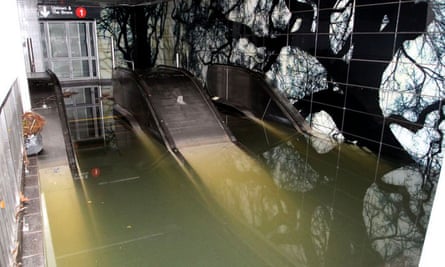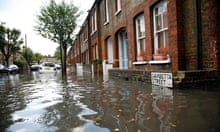Eighty-five sites on the London Underground are at high and rising risk of flooding, according to a report that says it is “only a matter of time” before serious flooding strikes.
Most threatened are some of the capital’s busiest stations, including Waterloo, King’s Cross and London Bridge, and the report warns of potential dangers to passengers. “The rapid nature of flooding events often produces high safety consequences,” it reads. The report was funded after Hurricane Sandy swamped the metro in New York City in 2012.
The London tube network is one of the busiest in the world, with more than 3.5m passenger journeys a day between 270 stations across the city. As well as the risk to passengers, closures and delays result in multimillion-pound losses for the tube and the wider economy.
The report finds the risk of flooding is rising due to climate change, and its findings reflect wider concerns about the UK’s preparedness for the impacts of global warming. Other critical infrastructure including the M25, Immingham container port and major electricity grid sites have all come close to disaster from flooding in recent years, and in March professionals warned that the healthcare system was “unprepared for devastating effects of climate change”.
Ian Uttley, a senior drainage engineer at London Underground (LU), said: “You can’t get an asset more vulnerable to flooding than a network of underground tunnels.”

The unpublished flood risk review, produced by LU and obtained by the Guardian, says: “London has been fortunate to escape the worst of recent storm events in the UK, but it is only a matter of time before heavy rainfall seriously affects London and the underground network. The risk is generally expected to increase [as] climate change predictions are that storms will become more intense. There is some evidence to show that these have already increased in frequency.”
Bob Ward, a member of the London Climate Change Partnership and policy director at the ESRC Centre for Climate Change Economics at the London School of Economics, said: “This is a shocking report that reveals the massive number of tube stations and sites at high risk of flooding. While it is good that LU is now aware of the scale of the risks, it is worrying that more has not been done to make the tube system more resilient to flooding. London has just been lucky that it has not been struck by a major flash flood recently.”
Ward said the mayor of London’s climate change adaptation strategy, published in October 2011, highlighted that the underground was the most vulnerable to flooding of all the city’s transport networks, but he said little had been done to reduce the risk: “It is a shameful legacy from Boris Johnson’s time as mayor.”
The LU report is its first on flood risk since 2001 and identifies 85 “high-risk” sites, of which 57 are stations and the rest are shafts and tunnel entrances. The stations in the top 10 of highest risk are spread across the city and include Finsbury Park, Notting Hill Gate, Seven Sisters, Colliers Wood, Stockwell and Marble Arch. Another 68 sites were identified as at “significant risk” by the report, including 23 stations.
The biggest risks are from flash flooding after heavy downpours and from burst water mains. Rainwater flooding regularly causes delays and at times in 2015 closed closed some lines, and in 2007 a train was left stranded. Ruptured water mains affect the tube an average of five times a year and in 2012 one incident sent 3m litres of water down a ventilation shaft between Mile End and Stratford, forcing the Central line to be closed for 26 hours at a cost of £4m.

LU has requested £3m over the next three years to analyse the riskiest sites in greater detail and to begin to install protective measures. But if the risk is to be significantly reduced, much more funding will ultimately be needed, said Anthony Fernihough, LU’s head drainage engineer. “£3m is not going to scratch the surface of it,” he said.
George McInulty, LU’s programme director for renewals, said: “We are investigating what more we can do to minimise any potential disruption flooding causes to our customers.”
Transport for London, which oversees the LU’s budget, is understood to be receptive to the plan but approval will depend on the mayor of London elected in May, who will become the chair of TfL and will appoint its board. In November the government announced it was cutting £700m a year of TfL’s funding.
“If the underground goes underwater we might finally see some real action on climate change from Westminster politicians,” said Guy Shrubsole, of Friends of the Earth. “Increasingly torrential rainfall of the sort experienced by people in the north of England this past winter poses a major danger to the tube. It’s clear that the government’s national flood resilience review must prepare the UK’s infrastructure for ever wetter weather, and take radical action to cut the pollution that’s changing our climate.”
In 2014 the Guardian revealed that government money spent on preparing the UK for the impacts of global warming had almost halved and the number of staff working on the issue had been slashed from 38 to six.










Comments (…)
Sign in or create your Guardian account to join the discussion